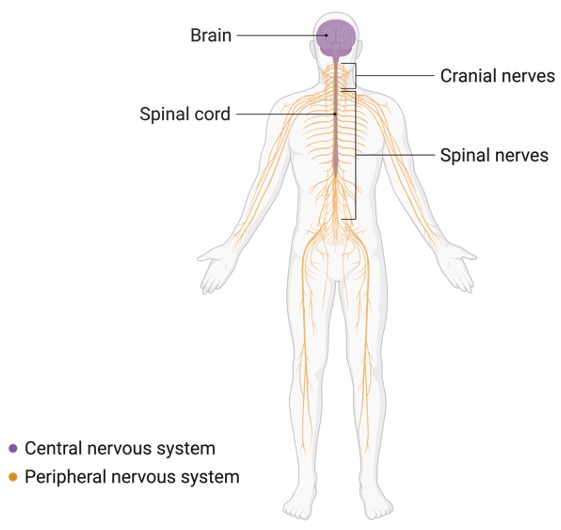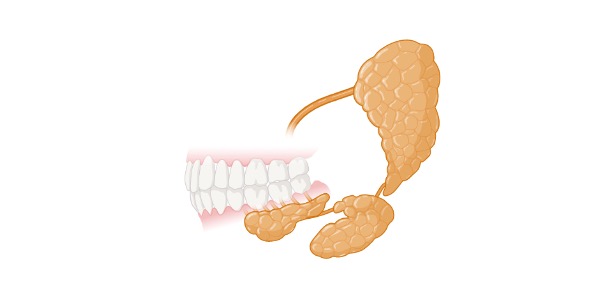Table of Contents
Sensory System Definition
A part of the nervous system consisting of a sensory receptor is called the sensory system. These sensory receptors receive stimuli from the environment and neural pathways and transfer this information to the brain, which further processes this information. If the information causes conscious awareness, it is called sensation.
Sensory System and Receptors
Receptors are the specialized endings of afferent neurons that collect information about the environment in different energy forms. The energy is known as the stimulus. The stimulus energy is received by receptor potentials. Stimulus transduction is the process by which a stimulus is transformed into an electrical response.
A certain type of stimulus has a specific receptor, which is known as its adequate stimulus. If the intensity of the receptor is sufficiently high, it can activate by a nonspecific stimulus.
Major Component of Nervous System

Receptor Potential
The change in ion flux across the membrane generates a graded receptor potential, which initiates an action potential, the magnitude of the graded potential, and frequency. The stimulus strength, summation of receptor potentials, and receptor sensitivity determine the magnitude of the receptor. Adaptation is defined as a decrease in sensitivity with a constant stimulus.
Neural Pathways in Sensory Systems
A sensory unit is formed by a single afferent neuron with all its receptor endings. The sensory unit stimulates and leads to activity in a specific afferent neuron, which is known as the receptive field of that neuron. After entering the CNS, the afferent neurons diverge and form many interneurons that are called ascending pathways. On the opposite location of their sensory receptors, the ascending pathways reach the cerebral cortex.

When the ascending pathway carries information about a single type of stimulus, it is called a specific ascending pathway. Examples of specific ascending pathways include the pathways that transfer information from somatic receptors, occipital lobe, and temporal lobe. Polymodal neurons form nonspecific pathways that activate by several types of sensory units. The examples include cortical association areas, memory, language, motion, etc.
Primary Sensory Coding
Four aspects of a stimulus are coded by sensory systems:
1. Stimulus Type (Modality): The same type of stimulus is sensed by all the receptors of a single afferent neuron.
2. Stimulus Intensity: A larger receptor potential produces an increased stimulus that leads to a higher frequency of action potential.
3. Stimulus Location: The precision of location, called acuity is negatively correlated with the amount of convergence in ascending pathways. Acuity can be increased by using lateral inhibition.
4. Stimulus Duration: At the onset of the stimulus, the rapid adapting receptors respond rapidly but it slows down during the remainder of a stimulus. The rapid adapting receptors are important in rapid change signaling whereas slow adapting receptors are important in signaling slow changes.
Somatic Sensation
Somatic receptors initiate the sensations from skin, muscles, and bone are called somatic sensations. Receptors for visceral sensations are similar.

Touch Pressure: There are two types of mechanoreceptors in the skin including rapid and slow adapting ones.
Posture and Movement: The skeletal muscles have muscle-spindle stretch receptors that respond to the absolute magnitude. It is also participated by mechanoreceptors in joints, tendons, ligaments, and skin.
Temperature: Thermoreceptors are classified into two types, the first one responds to an increase in temperature while the other one responds to a decrease in temperature.
Pain: The intense mechanical deformation causes tissue damage. Hyperalgesia is the stimulus of pain that increases sensitivity to subsequent painful stimuli. The inhibition of the transmission of pain stimuli by descending pathways leads to a suppression of pain. The process is called stimulation-produced analgesia. The referred pain is the sensation of pain at a site different from the actual part.
It occurs due to the convergence of both visceral and somatic afferents on the same interneuron. Transcutaneous electric nerve stimulation (TENS) is a therapy that inhibits neurons in the pain pathway by stimulating non-pain afferent fibers.
Optic
Vision: These receptors are only sensitive to the visible light of the electromagnetic spectrum. The impinging light rays into an image are focused by the lens and cornea. The curved surface of the cornea plays an important role in focusing while the zonular fibers make adjustments to be changing shape of the lens.
The zonular fibers are controlled by the smooth ciliary muscle. The lens has transparent cells that lose their organelles. A cataract is a phenomenon, in which the lens becomes opaque by replacing older cells with newer cells. Sometimes the elasticity of the lens loses due to age and cannot assume a spherical shape, which results in presbyopia (loss of near vision).
The far vision becomes poor if the objects focus in front of the retina, similarly, if the objects focus behind the retina, the near vision becomes poor. Astigmatism can occur if the lens or cornea is not smooth. The pupil is located at the center of the opaque iris that controls the amount of light.
Photoreceptor Cells: The photoreceptor cells are of two types including rods, and cones. The cones are less sensitive whereas the rods are more sensitive. The cones are further classified into three types that contain red, green, or blue-sensitive pigment.
The photopigments present in the photoreceptors absorb light. The photopigments are of our types including rhodopsin in rods and three cone types. Integral membrane protein, named opsin is present in each photopigment, which binds to a chromatophore. Each photopigment consists of a different opsin that absorbs light at a different wavelength.
The retinal activates in presence of light and triggers hyperpolarization in the bipolar cells. The bipolar cells synapse with photoreceptor cells and activate them, which leads to a change in the shape of the retinal into its resting shape.
Neural Pathways
The first action potential is produced by synapses of photoreceptor cells with bipolar cells that in turn synapse with ganglion cells. The optic nerve is formed by axons of ganglion cells, which cross over to the opposite side of the optic chiasm.
Sound Transmission in Ear
• Outer ear- Also known as pinna or auricle. It directs and amplifies sound waves
• External auditory canal- it leads to the middle ear cavity from outside
• The tympanic membrane- known as the eardrum, causes vibrations
• Middle ear cavity- made up of a chain of 3 bones, named the malleus, incus, and stapes.it is filled with air
• Oval window- it receives vibrations from the middle ear cavity. It separates the middle ear and inner ear
• Inner ear- also known as the cochlea
• Scala vestibule- filled with fluid
• Cochlear duct- lined by the basilar membrane
• Organ of Corti
The organ of Corti has receptors cells that have hairlike stereocilia. The hair cells are stimulated by the vibrations and the pressure waves transformed into receptor potentials.
Neural pathways: The cochlear nerve is formed by afferent neurons from the hair cells.
Hearing: The audible range is 20 to 20,000 Hz, while human ears can tolerate sounds to 85 decibels. Hearing can be damaged by exposure to prolonged loud sounds, it is mainly caused by exposure to a frequency range of 4000-6000 hertz. By reducing noise or by moving away from the source of noise, the damage can be prevented. Some method to avoid noise includes installing specialized soundboards, acoustical tiles for ceilings, or insulation.
Vestibular System: It is a series of tubes filled with fluid located in the inner ear. It has two parts-
1. Semicircular Canals: During rotation of the head, it detects angular acceleration.
2. Utricle and Saccule: It provides information about linear acceleration.
Vestibular Information: The parietal lobe gets information from the vestibular apparatus and also integrates with the information from other body parts that leads to a sense of posture and movement. Motion sickness can be caused due to unexpected inputs from the vestibular system.
Chemical Tastes
Taste: Tongues have taste buds that mainly respond to 4 modalities sweet, sour, salty, and bitter. There are different transduction systems for each modality. However different taste categories may respond by a single receptor.
Smell: The olfactory epithelium consists of olfactory receptor cells that are located in the upper part of the nasal cavity. These cells contain binding sites for olfactory stimuli in their non-motile cilia. Only one type of receptor is present in each cell. Axons of olfactory receptor cells of the same specificity synapse together and pass the information into the olfactory cortex in the limbic system.
Sensory System Citations
- Mechanisms of cell specification and differentiation in vertebrate cranial sensory systems. Curr Opin Cell Biol . 2020 Dec;67:79-85.
- Activity-dependent axonal plasticity in sensory systems. Neuroscience . 2018 Jan 1;368:268-282.
- Sensory systems in birds: What we have learned from studying sensory specialists. J Comp Neurol . 2020 Dec 1;528(17):2902-2918.
- Figures are created with BioRender.com







